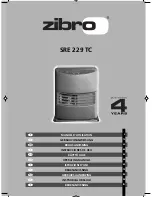
5 - 15
MAINTENANCE
Read all of this manual to become thoroughly familiar with this vehicle. Pay particular attention to all Notices, Cautions, Warnings, and Dangers.
5
Wrap wrenches with vinyl tape to prevent the possibility of a dropped wrench
from ’shorting out’ a battery, which could result in an explosion and severe per-
sonal injury or death.
Battery
A battery is defined as two dissimilar metals immersed in an acid. If the acid is absent or if the metals are not dissim-
ilar, a battery has not been created. The batteries most commonly used in these vehicles are lead acid.
A battery does not store electricity, but is able to produce electricity as the result of a chemical reaction which
releases stored chemical energy in the form of electrical energy. The chemical reaction takes place faster in warm
conditions and slower in cold conditions. Temperature is important when conducting tests on a battery and test
results must be corrected to compensate for temperature differences.
As a battery ages, it still performs adequately except that its
capacity
is diminished. Capacity describes the time that
a battery can continue to provide its design amperes from a full charge.
A battery has a maximum life, therefore good maintenance is designed to maximize the
available
life and reduce the
factors that can reduce the life of the battery.
BATTERY MAINTENANCE
Tool List
Qty.
Tool List
Qty.
Insulated Wrench, 9/16" .............................................. 1
Battery Carrier......................................................... 1
Hydrometer ................................................................. 1
Battery Maintenance Kit P/N 25587-G01................ 1
At Each Charging Cycle
To reduce the possibility of fire, never attach a battery charger to a vehicle that is to be unattend-
ed beyond the normal charging cycle. Overcharging could cause damage to the vehicle batteries
and result in extreme overheating. The charger should be checked after 24 hours and unplugged
after the charge cycle is complete.
Before charging the batteries, inspect the plug of the battery charger and vehicle receptacle housing for dirt or
debris.
Charge the batteries after each day’s use.
Monthly
•
Inspect all wiring for fraying, loose terminations, corrosion or deterioration of insulation.
•
Check that the electrolyte level is correct and add suitable water as required.
•
Clean the batteries and wire terminations.
•
Coat battery terminals with commercially available protectant.
Electrolyte Level and Water
The correct level of the electrolyte is 1/2" (13 mm) above the plates in each cell.
This level will leave approximately 1/4" - 3/8" (6 - 10 mm) of space between the electrolyte and the vent tube. The
electrolyte level is important since any portion of the plates exposed to air will be ruined beyond repair. Also avoid fill-
ing with too much water, which will result in electrolyte being forced out of the battery due to gassing and a decrease
in volume of the electrolyte that results from the charging cycle.
Содержание Express L4 - Electric
Страница 1: ...622014 Owner s Guide ISSUED JULY 2011 REVISED JUNE 2012 ...
Страница 81: ......
















































